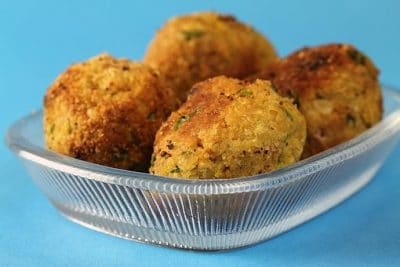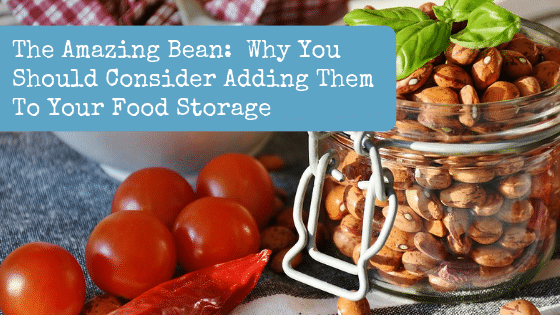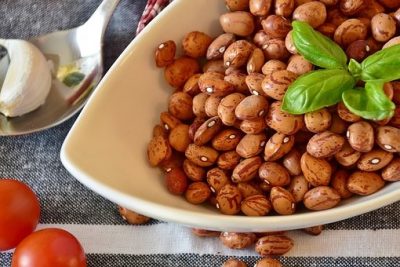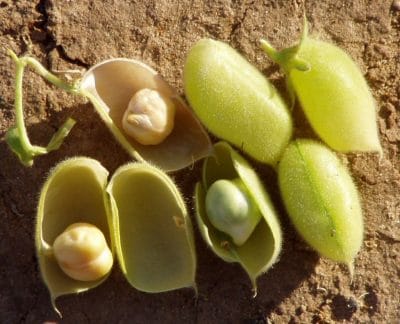This site contains affiliate links. As an Amazon Associate, I earn a commission from qualifying purchases at no extra cost to you. Full Disclosure Here.
When planning your food storage one of the major goals should be to store items that are of the highest nutritional value and with a long, stable shelf life. Enter the lowly bean!
Dried beans are inexpensive and can be kept for 30+ years if packaged and stored properly, making them a perfect food for long-term emergency storage. Additionally, they are not usually an allergenic food and can add adequate nutrition and calories for maintaining health and energy, a much-needed quality for survival scenarios. Beans can be the backbone of long-term food plans. There are beans that do not need long soaking and some that need a full 24 hours (Soy Beans)
In this article, we’ll discuss basic storage, bean varieties, calories, nutrition, soaking, health benefits, and cooking, along with a few good recipes to help dried bean storage be a part of your effective long-term plan.
Because of their relatively low cost, low cholesterol and low maintenance – balanced with high protein, high fiber (both soluble and insoluble), high vitamins and minerals like folate, potassium, iron and magnesium, and their high versatility – beans are a great addition to any meal and are a healthy meat substitute. Among all groups of food commonly eaten all over the world, no group has a more health supportive mix of protein and fiber than legumes.
Let’s discuss one of the main roadblocks people may experience in bean consumption.
BEANS AND GASTRIC DISTRESS

Since beans are a perfect addition to long-term storage you don’t want to dismiss them without trying to work things out with your gut, if possible.
Here are a few “helps” in that department.
- Beans are one of the hardest foods for your intestines to digest, if your system has trouble with them, try a Beano tablet before eating – it usually works. If it does then store some Beano along with the beans.
- If you have been diagnosed with IBS (irritable bowel syndrome) usually you should just plain stay away from legumes (Beans, Peas, and Lentils)
- Start eating beans gradually. Introduce them to your tummy with caution and in small amounts, very gradually increasing the frequency and amount you consume. If you begin to experience a problem, back away for a little while or decrease your portion size. Give the experiment adequate time to discover if your sensitivity will decrease.
- There is a small part of the population that truly can’t tolerate any legume. The “gas effect”, FODMAP stands for “Fermentable Oligo-, Di-, Mono-saccharides and Polyols and as these sugars ferment they cause all that gas and bloating that is associated with the “musical fruit”…oh I’m betting that you remember that song!
- But there may be a way around this dilemma. Soaking the offending legume in water tends to greatly decrease this social and painful bother, at least for a good percentage of people. According to Dr. Joseph Rackis of the USDA, flatulence from legumes results when undigested complex sugars in the lower intestine are acted upon by naturally occurring bacteria. These complex sugars (called trisaccharides) are water soluble, and soaking and frequent rinsing of the beans wash them away.
- Sprouting is even more effective in solving the problem. I am not totally sure why this is so but I think it has something to do with the phytic acid reduction and the change in enzymatic production when the bean sprouts. They don’t have to sprout much. Just a 1/8” sprout seems to work and causes the bean to be more digestible. At this point in sprouting they can still be used in the same way you would use an unsprouted bean; in soups, stews, salads etc.
Consider What is Best for You and Your Family
Before heading out to make a large dried bean purchase it is prudent to consider which beans, peas, legumes your family already enjoys. In the south it might be black-eyed peas or pinto beans, out west it might be kidney beans for chili. Whatever your family already enjoys; put that on your list.
Experiment
Next, think about buying a 1 lb. bag of each of a variety of beans that your family might like. Perhaps trying out a few varieties that are new to you would be helpful. Then, over a period of time test them on the people you will be storing for. You’ll quickly discover the real winners and losers. This will help you feel assured that you are making a useful purchase. It will also give the cook more experience in cooking beans. This time will most definitely highlight anyone who has gut issues with beans, allowing that issue to be addressed before a crisis situation arises.
Storing Beans
1. Remove any broken beans or pebbles that you notice.
2. For shorter term storage, transfer your dried beans to a food-safe storage container with a tight-fitting lid. If stored in their original plastic bag, they’ll dry out in less than 2 years.
3. Dried beans must be heat sealed with an added oxygen absorber for 30+ year storage to be achieved. They should be sealed in 3.5 to 5 mil Mylar bags, a #10 can or for larger quantities of dried goods, choose food grade buckets paired with a 5 gallon Mylar bag, heat sealed and with oxygen absorbers. Make sure the buckets are food grade. Absorbers range in size. Larger ones absorb more oxygen and are needed for those 5-gallon bags.
Do not use the free buckets from local bakeries for storing any type of food because they sometimes have toxic cleaning product residue. Use those buckets for storing non-food items. Here are some links for Mylar bags and oxygen absorbers:
- 1 Gallon Mylar bags
- Dry-Packs Mylar Bags and 300cc Oxygen Absorbers
The Mylar bag must be heat sealed after adding the beans and an oxygen absorber. There are good handheld sealers available online. Two other useful sealing tools are hair straightening wands and a clothes iron. One of the seal-a-meal devices will work but the sealer would have to be large enough to accommodate the bag opening. There are zip closed Mylar bags and those are great for short term storage of light-sensitive herbs and spices. Of course, you may use a heat seal in addition to the zip and this can make it easier to use the contents gradually once the bag is opened but be aware that this adds substantially to the cost. For additional information about using Mylar bags see this.
4. Place the containers in a cool, dry place away from sunlight.
5. Rotate what you store to get optimal freshness. To learn more about how to effectively use food storage rotation see a previous BDS post.
TIP: If old beans become dried out and hard in spite of soaking do not throw them out! (Although you can’t grind wet beans you can grind any dried beans in your sturdy grain grinder or if you have a heavy duty blender, like Vitamix or BlendTec Classic that will work too.
This bean flour can then be turned into a nutritious creamy bean soup by adding water with a ham bone if you have one, onions, garlic, carrots or greens and any spices you like, simmer until fully cooked. Next, remove the ham bone and blend all ingredients together with a handheld blender. Add some butter, milk or cream if you like.
VARIETY
The variety of those little edible beans is more than amazing. We’ll quickly cover 13 varieties, each with a distinctive taste and texture. There are 100’s of other varieties but I’ve chosen these because they are plentiful and most are popular. In a time of emergency and struggle, people gain comfort from eating familiar foods. There will be a few tasty but easy bean recipes included if you care to try any of them.

1. Black Turtle Beans
Because of its fantastic nutrients, Black Beans should be included in every food storage plan. A one-cup serving of cooked beans has an amazing nutritional profile. This is the “Queen of Beans” in our house because the benefits mentioned below are just the tip of the “healthy” iceberg.
I would recommend that black turtle beans be included in most food storage plans. There are 227 calories in each cup—in a survival situation may be hard to find the needed daily calories. This is a home run along with several other beans on this list.
227 Calories
15 grams protein
15 grams fiber
64% folate
40% copper
38% manganese
35% vitamin B1 Thiamine
30% magnesium
24% phosphorus
20% iron
Black Bean, Feta and Cuke Salad
Prepare the black beans.
Mix together:
- 6 cups of cooked black beans
- 1 cucumber peeled and chopped into cubes
- 1 cup feta cheese, crumbled
- 1 large sweet onion thinly sliced or chopped
- ¼ cup good extra virgin olive oil.
- Chopped cilantro or young dandelion greens to taste, about ¼ cup.
- Add about a teaspoon of salt and a few grinds of pepper to taste.
- Fresh dill weed to taste, optional
- 3 Tablespoons of lime juice
Toss altogether to combine ingredients and serve cold or at room temperature.
Black Bean Soup with Red Pepper Salsa and Home Churned Butter
2. Black-eyed Bean
One look at a blacked eyed pea and you know how they got their name. This bean (or pea as it is sometimes called in the southern U.S.) is best paired with leafy green veggies like collard greens; at least that is what my granny used to use. And there was always a big cast iron skillet of steaming cornbread and a small crock of bright yellow home churned butter!
But there are only 70 calories per cup. For a prepper, calories are a large consideration especially if beans are only an adjunct to instant dehydrated commercially prepared meals where the caloric supply can be lacking. However, we need variety and if black eyed beans are your families favorite then adding these as part of your plan may be good for morale.
70 calories
4 grams fiber
12% iron
3. Red Kidney Beans
215 calories
6 grams sugar
10 grams fiber
2.6 grams iron
16 grams protein
- According to DASH, you may consume about 3 servings per week of kidney beans, along with other foods, as they are a rich source of protein, fiber, energy, and magnesium.
- Also according to a study by Celleno, Leonardo, Maria Vittoria Tolaini, and Alessandra D’Amore, kidney beans are fiber-rich which help control blood sugar levels and promote healthy elimination but they may cause flatulence in some people.
- There are three types of kidney beans — light red, dark red, and cannellini kidney beans which are creamy white and slightly milder in taste.
- Kidney beans, along with other legumes have that hearty umami flavor that can satisfy cravings for the taste of meat.
- Kidney bean extract, especially of the white bean, helps with weight loss without any effect on the lean body mass by inhibiting alpha-amylase, which is important for digestion.
- Kidney beans are one of the best sources of protein.
- Pregnant women are more apt to have gastric issues with kidney beans so either avoid them or check with your obstetrician.
- Recipe: Your favorite chili.

4. Adzuki Beans
If you’re looking for an easy to digest protein, adzuki beans are a great bean to add to your diet and food storage plan. They present less gastric issues than any other bean but the chickpea is close behind. So for those in your home who may not be able to comfortably eat other beans, I’d suggest trying the Adzuki bean in your trial run. There are other reasons to eat this bean.
Although they are a little more pricey than other beans I included them in this list because they really pack a superfood punch as you can tell from the list below.
One cup of cooked Adzuki beans contains about:
294 calories!
57 gms. carbohydrates
17.3 gms. protein
0.2 gms. fat
16.8 gms. fiber
278 mcg. folate (70 % DV)
1.3 mg. manganese (66 % DV)
386 mg. phosphorus (39 % DV)
1,224 mg. potassium (35 % DV)
120 mg. magnesium (30% DV)
Adzuki is a small red bean with a firm texture and a rich nutty flavor with a hint of sweetness. It is perfect for salads, soups, chili, and veggie burgers. Adzuki beans are the main ingredient in Anko, a sweet red bean paste used in Japanese desserts.
Compared to kidney beans, adzuki beans have more calories, protein, and fiber per serving. When it comes to vitamins and minerals, adzuki beans lead other beans in almost every marker.
Another plus for the little red bean is that there is no need to soak them unless you need to do that it decreases possible flatulence; just sort and rinse 1 cup beans. Place in pot with 3 cups water. Cover and bring to a boil. Reduce heat to medium-low and cook until beans are tender about 1 hour. Add more water as needed while cooking to keep beans covered. Test for tenderness with a fork. Yields about 3 cups.
Aduki beans are not usually found in your local grocery market yet but they are available at most health food stores and online.
5. Lima Beans
Calories 216
molybdenum 313% DV
copper 49% DV
fiber 47% DV
manganese 42% DV
folate 39% DV
phosphorus 30% DV
protein 29% DV
iron 25% DV
vitamin B1 25% DV
potassium 20% DV
Low on glycemic index
A Few Diseases that may be Improved by Consuming High Fiber, Low Glycemic Index Foods

Heart Attack and Stroke Risks: When researchers analyzed data in relation to the risk of death from heart disease, they found that higher consumption of legumes was associated with a whopping 82% reduction in risk!! This is mainly a result of high fiber intake and you have noticed that all beans we have mentioned have a very high fiber content in common. So eat more legumes.
Folate, also known as folic acid or vitamin B9, helps to lower levels of homocysteine. Elevated blood levels of homocysteine are an independent risk factor for heart attack, stroke, or peripheral vascular disease. It has been estimated that consumption of 100% of the daily value (DV) of folate would, by itself, reduce the number of heart attacks suffered by Americans each year by 10%. Black beans and Adzuki lead the pack in the percentage of folate per one cup of beans. Folate is also considered important during pregnancy.
Take a look at the folate content in mung beans below! Since folate (folic acid) is mainly derived from leafy green vegetable and citrus, which are less likely to be available in long-lasting critical times, beans in your storage is a necessity to maintain prevent anemia.
6. Mung Beans
Calories 212
Protein 14 gms.
Fiber 15 gms
Folate 321 mcg 100% DV
Magnesium 97 mgs 30% DV
Vitamin B1 .33 mgs 36% DV
Mung beans have the ability to regulate cholesterol levels because their antioxidants act like potent free-radical scavengers, reversing the damage done to blood vessels and lowering inflammation. Mung beans are a great addition to any anti-inflammatory diet because of their wonderful ability to keep arteries clear and to help improve circulation.
They also make nutritious bean sprouts. Store a pound of bean sprouting seeds in a sealed glass jar and they will make pounds and pounds of “greens”. This is an easy way to store living sprouts and is a needed addition to a well-balanced storage supply. Check out this BDS article for more information on sprouting beans and other seeds.
7. Navy Beans
A Story: Before we talk about navy beans I want to share a short true story. There is a couple I know who have the last name of Bean. They have three children. They have named them Navy, Boston and the 1-year-old is Lima…no joke! The children, so far, don’t seem to mind their unique monikers.
Navy Bean Nutrition Facts per 1 cup servings
Calories 255
Folate 64% DV
Fiber 68% DV
Copper 42% DV
Manganese 45% DV
Phosphorus 37% DV
Vitamin B1 36% DV
Protein 30% DV
Iron 54% DV
Magnesium 28% DV
Vitamin B6 20% DV
Cholesterol Study: Healthline had this to say about navy beans and health: “An interesting study of 38 children who had abnormal blood cholesterol found that those who ate a muffin or smoothie containing 17.5 grams of navy bean powder every day for four weeks had higher levels of healthy HDL cholesterol.”
Similar effects have been found in adults.
What About Incomplete Proteins?
According to SFGate, “Even though you do get lots of protein from beans, it isn’t complete. Beans are lacking in one or more of the essential amino acids you need from your diet. If you eat meat, dairy or seafood, you don’t have to worry – these foods already have all of the essential amino acids your body requires.”
However, if you pair grains, eggs or dairy with beans, there you go….a complete protein.

7 and 8 Split Peas: There is no soaking needed for split peas. They cook very quickly, in fact, it is easy to overcook these delicate peas. Just make sure to search through them and remove any pebbles, discolored or shriveled peas you see. The only way I ever prepare these is as a split pea soup.
RECIPE: Split Pea Soup. Simply add 2 cups of split peas to chicken stock or water, enough to cover by 2- 3”. Green or yellow peas or a mix of both. Add salt and pepper to taste and a dash of garam masala or Chinese 5 spice if you have it. When peas are soft use a handheld blender and blend well. Now add a chopped onion that you’ve sautéed in olive or coconut oil until golden. If you like ham you can sauté some ham cubes with the onion then add to the blended soup. Add a dash of cayenne, optional. You may add more stock or water if you want the soup to be thinner. Taste and tweak as you prefer. This is a forgiving recipe so use your imagination.

9. Brown Lentils 10. Black Lentils 11. Orange Lentils 12. Green French Lentils
Calories 231
Molybdenum 327% DV**
Fiber 58% DV
Copper 39% DV
Protein 33% DV
Folate 32% DV
**Molybdenum acts as a cofactor for four enzymes. These enzymes are involved in processing sulfites and breaking down waste products and toxins in the body. Only trace amounts are needed so deficiencies are rare.
Brown lentils are the most common and easiest to find lentil in the grocery market. The other three can be found in health food stores or online. For about the first year of our marriage, we ate lentils just about every day. They were inexpensive, good-for-you and tasty….at least for a while. After that year I came to realize firsthand the glories of variety! Keeping variety in your food supplies is important for nutrition, morale and just to add more “life” to your meals.
A good quality possessed by beans and especially the lentil is that they accept added vegetables nicely and are not overwhelmed by them. Add foraged greens and wild onions. If you have ground beef, brown it and add that as well. All root veggies work well with beans soups and stews. Carrots add a hint of sweetness that is refreshing and with carrots in pureed soups children who may not like a particular vegetable eat them and are blissfully unaware!
Chickpeas or Garbanzo Beans

If you have never used chickpeas in making either hummus or falafel now is the time to begin so your family becomes familiar with a new food before there is a shortage or an economic crisis. One of the greatest things about being able to store chickpeas long term is that you are storing a nourishing meat substitute. This would be a welcome relief if little or no meat availability.
They are low on the glycemic index and are a great source of protein and fiber, all qualities that support healthy blood sugar control.
Calories per cup —- 269
- Chickpeas (English term) are sometimes known as garbanzo beans (Spanish term).
- They are used abundantly in Mediterranean and Middle-Eastern food.
- Soak them in water for 14 to 18 hours before cooking for best results.
- Chickpeas become a crisp, savory snack when roasted. You can season them any way you like. We think Old
- Bay seasoning is fantastic sprinkled lightly just after roasting with olive oil drizzled over the top.
Falafel Made from Chickpeas

Falafel:
https://www.youtube.com/watch?v=foB6bxhZYF0
Hummus and Falafel:
https://www.youtube.com/watch?v=Pd8_SyK-5i4
Below is a dip recipe that is irresistible and no one would ever know that the base ingredient is simply healthy chickpeas! Use this dip with apples, pears, bananas or snack crackers. This could be a good introduction to chickpeas for your family since chickpeas are quite bland-tasting by themselves and so become more versatile by being able to carry added flavors.
Chocolate Chickpea Spread
6 cups chickpea, cooked
1 ½ cups raw coconut oil
¾ cup coconut milk
6 Tbsp. cocoa powder
1 Tbsp. vanilla extract
¾ cup real maple syrup
½ teaspoon sea salt
Blend all in a food processor.
Yield 4 ½ lbs. This recipe can be halved.
Chickpeas in their Pods
FINAL THOUGHTS
We all know that being prepared for emergency scenarios by having a basic supply of food and water is an essential part of survival. We do not know what that scenario may be or how long it may last.
If we have a year’s supply of basic foods and keep in mind the adage, “Store what you use and use what you store”. And if we are diligent in using a rotation plan, the money we spend will be an investment and the food will be used up gradually and replaced as it is used. I hope the reader takes away that storing and using dried beans can be a wise investment, both in funds and for the health of us and our loved ones.
As I mentioned before; when planning your food storage one of the major goals should be to store items that are of the highest nutritional value and with a long, stable shelf life.
I hope you enjoy experimenting with new bean recipes, discovering how they are tummy-tolerated and finding your family’s favorites to add to your food supplies!
A new article will be coming on how to make beans a light, quick-cooking bug-out food.
Blessings,
Donna
If you enjoyed this article, consider following our Facebook page.
Need more help with basic food storage and supply? Get Backdoor Survival LIFELINE














13 Responses to “The Amazing Bean: Why You Should Consider Adding Them To Your Food Storage”
Thank you Zabeth. Glad you are enjoying the bean recipes.
In answer to you questions about cooking and eating bean sprouts: we always eat them fresh, within 3-4 days after sprouting. The sprout can grow until the bean itself is quite shrunken. Eaten raw the nutritional value is at its peak. I have never felt the need to dehydrate them because storing the beans and sprouting them when needed, seems to be the best option for freshness and ease of use. This is true for seed sprouts too, mung, alfalfa, clover, radish, broccoli etc. Used fresh they retain their fresh tangy taste too.
I hope I understood your question and answered it appropriately!
Hey Matt in Oklahoma,
Good plan Matt. Beans and rice are especially needed when there is an allergy to wheat and other grains which are the base of many food storage plans. For my money beans are better at fulfilling nutritional requirements than grains as well. I hope you are storing white rice since brown rice quickly becomes rancid so is not a good long-term item. Thanks for taking the time to comment!